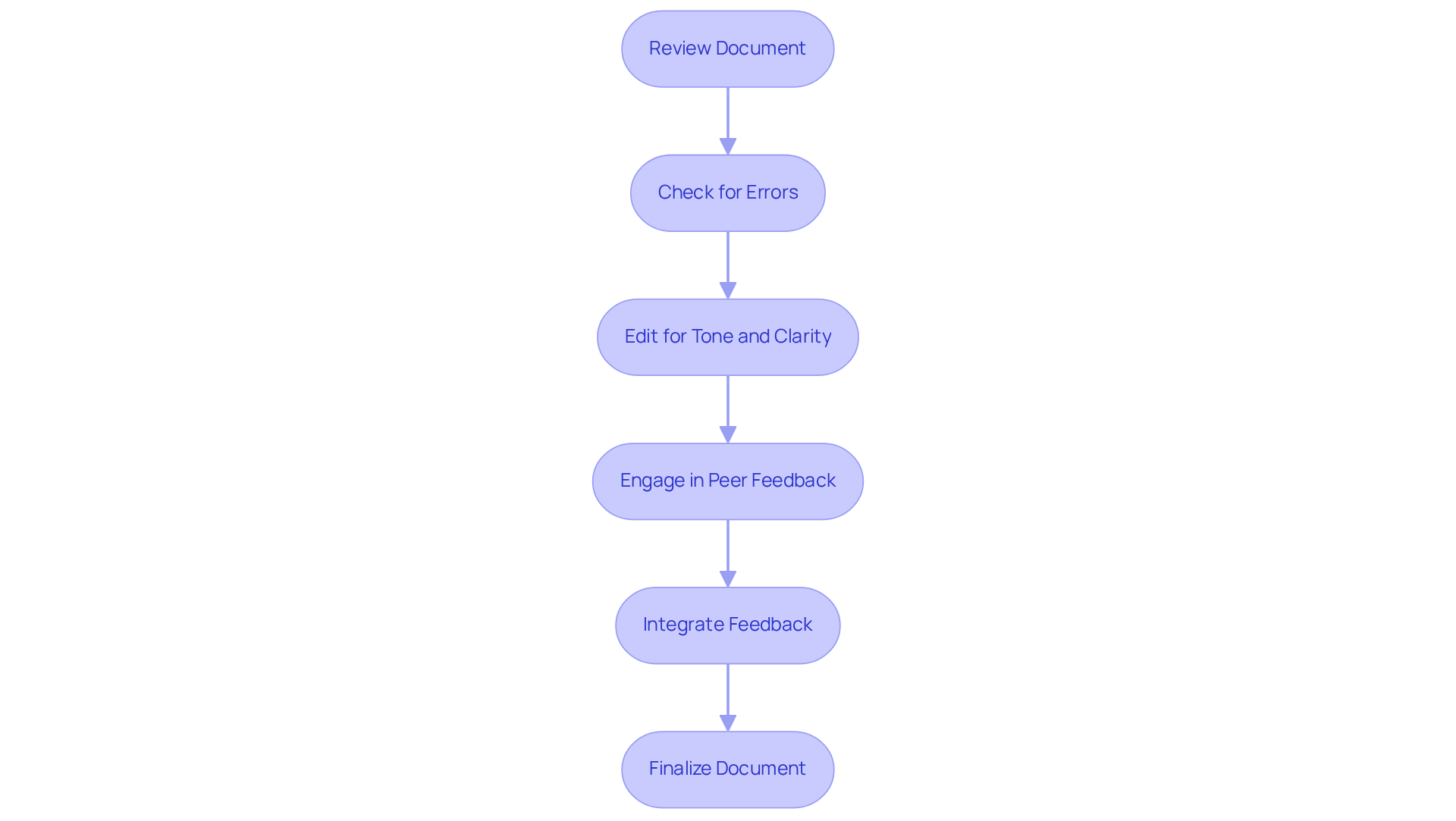
Automation and Documentation
|
October 16, 2025
|
How to AI Generate Documents for Streamlined Operations
Overview
You might be wondering how AI-generated documents can really make a difference in your daily operations. Well, they streamline the whole creation process by using natural language processing and machine learning. This means you get to save time, reduce errors, and boost efficiency—all pretty great benefits, right?
The article dives into how AI tools can whip up documents with significantly fewer mistakes compared to what a human might do. Plus, it highlights why it’s super important to know your document's purpose and audience to really engage your readers effectively.
So, let’s explore how these tools can transform your documentation game!
Key Highlights:
- AI content creation utilises natural language processing and machine learning to automate document generation.
- Benefits of AI document generation include time savings, reduced errors, and enhanced efficiency.
- Choosing the right AI tool involves assessing document needs, customization, and budget; popular options include Google Cloud Document AI and Microsoft 365 Copilot.
- Understanding the document's purpose and audience is crucial for effective content creation and engagement.
- Statistics show that focused materials can increase viewer engagement by up to 70%.
- Automated systems for data entry have accuracy rates of 99.959% to 99.99%, significantly lower than human error rates.
- Peer feedback on generated documents enhances quality and fosters collaboration, with a strong correlation to improved content quality.
- Finalising a document involves reviewing for accuracy, coherence, and ensuring it meets quality standards before distribution.
Introduction
In a world where efficiency is everything, you might be wondering how artificial intelligence is changing the game in document generation. Well, it’s pretty exciting! By tapping into AI's capabilities, businesses can automate the creation of all sorts of documents. This not only saves time and cuts down on errors but also boosts overall productivity.
But with so many AI tools out there, how do you figure out which one is the right fit for your needs? Understanding the ins and outs of AI document generation can really streamline your operations, but it also brings up some important questions about:
- Customization
- Engaging your audience
- What the future holds for workplace efficiency
So, let's dive into this together!
Understand AI Document Generation
You might be wondering what AI content creation is all about. Well, it’s all about using artificial intelligence technologies to automatically whip up materials based on what you input or some templates. This nifty process taps into natural language processing (NLP) and machine learning algorithms to analyze data and churn out coherent text.
Understanding the basics of AI content creation means recognizing how AI generates documents can save you time, reduce mistakes, and enhance efficiency by automating those repetitive tasks we all love to hate.
So, why not get familiar with some popular AI applications and their features? This knowledge will help you make smarter choices as you dive into the content creation process.

Choose the Right AI Tool for Your Needs
You might be wondering how to pick the right AI resource that can ai generate documents for your content creation needs. Start by thinking about what you really require. What kind of documents do you need AI to generate documents for? How much customization are you looking for? And, of course, what’s your budget? Once you have a clear picture, it’s time to explore the AI options out there that can help you ai generate documents, such as:
- Google Cloud Document AI
- Microsoft 365 Copilot
- Templafy
Look for features that matter to you, such as:
- Template management
- How well they integrate with your existing software
- How user-friendly they are
Checking out user reviews and case studies can give you some great insights into how these tools work in real-life scenarios. Speaking of insights, did you know that 90% of AI users say this tech helps them save time? That’s a pretty compelling reason to give these resources a shot!
And here’s something to think about: 72% of organizations around the globe are already using AI in at least one part of their business. It’s clear that adopting AI resources to ai generate documents is becoming a necessity. Before you dive in, why not try out some trial versions? It’s a smart way to test the waters without committing right away. As Albert Badalyan points out, the global AI market is set to hit over $800 billion by 2030. That’s a huge opportunity for enhancing your business operations!

Define Your Document's Purpose and Audience
Before you dive into creating your file, let’s take a moment to nail down its purpose and pinpoint your target audience. You might be asking yourself: What’s the main goal of this text? Is it to inform, persuade, or instruct? Understanding the purpose will shape both the content and structure of what you’re about to create.
Now, let’s talk about your audience. Consider who they are—what’s their knowledge level, what interests them, and what do they prefer? Tailoring your content to meet these needs can really boost engagement and effectiveness. In fact, studies show that well-focused materials can ramp up viewer engagement by as much as 70%! That’s a pretty big deal, right?
Next up, sketch out a concise outline that highlights the key points you want to cover. This outline will help ensure that your content aligns with your text's intention and your audience's expectations. For instance, a product team might zero in on technical specs for a savvy group, while an operations manager might focus on clear, actionable steps for a wider audience. By understanding and addressing your viewers’ specific needs, you can create materials that not only inform but also connect and inspire action. So, let’s get to it!

Input Information and Generate Your Document
To effectively use AI resources for crafting written content, you’ll want to start by clearly outlining what you aim to achieve and who your audience is. You might be wondering, what’s next? Well, the next step is to pick a template that fits the type of material you’re producing. Then, input all the essential information—think titles, headings, and key points—making sure everything is clear and concise. Many AI applications offer prompts or questions to help guide you through this process. For instance, you could ask, 'What are the main advantages of using AI for creating written content?' Once you’ve entered all the necessary data, just kick off the file creation process. The AI will analyze your inputs and whip up a draft based on the information you provided.
Now, let’s talk numbers! Statistics show that human data entry can lead to error rates between 1% and 4%, while automated systems boast accuracy rates of 99.959% to 99.99%. To put that in perspective, for 10,000 data entries, automated systems would make only about 1 to 4.1 errors, whereas humans could rack up between 100 and 400 errors. That’s a pretty stark contrast! It really highlights why leveraging AI tools to generate documents is crucial for minimizing mistakes and boosting efficiency. In fact, organizations that utilize AI to generate documents for content creation have seen significant reductions in processing times and overall productivity, making it a smart choice for managing operations.
Speaking of transformation, check out what Anastasia Masadi, a Product Owner, has to say: "SowFlow has transformed how we record work and provide for our clients. I don’t have to take each screenshot separately, and I don’t even have to leave the browser while I’m creating SOPs and training materials. SowFlow gave me time from my life back." This testimonial really shows the game-changing impact of SowFlow on documentation efficiency, illustrating how it empowers teams to create SOPs and training materials in an instant.

Review and Refine Your Generated Document
Once your file is ready after the ai generate documents process, you might be wondering what comes next. The next step is to carefully review and refine the content. Start by reading through the document to check for accuracy and coherence. Are there any inconsistencies or errors that slipped through during the generation process? It’s crucial to ensure that the tone and style fit your intended audience, so feel free to make edits to enhance clarity and flow.
Now, let’s talk about the power of peer feedback. Engaging your colleagues or stakeholders for their insights can really boost the quality of your writing. You might be surprised by the valuable perspectives you could overlook on your own. A recent study showed that peer feedback not only enhances the quality of the text but also fosters a collaborative atmosphere where ideas can flourish. As Zong et al. noted, "Feedback is widely viewed as useful for learning and self-regulation." Plus, the reliability of lengthy remarks in peer feedback has been shown to be 0.89, indicating a strong correlation with improved content quality. But be careful—low-quality feedback can lead to a false sense of confidence among reviewers. Once you’ve integrated the feedback and feel good about the revisions, it’s time to finalize the document for distribution or publication. Just make sure it meets the highest standards of quality and relevance!

Conclusion
You might be wondering how embracing AI for document generation could really change the game for your business. Well, it’s a transformative step that can lead to streamlined operations. By automating the creation of various documents, you can significantly boost efficiency, cut down on errors, and save valuable time. This integration of artificial intelligence doesn’t just optimize workflows; it also frees you up to focus on more strategic tasks.
Throughout this article, we've shared some key insights on how to select the right AI tools that fit your specific needs. We’ve talked about:
- Understanding the purpose and audience of your documents
- The essential steps for generating and refining your content
With a wealth of AI applications at your fingertips, like Google Cloud Document AI and Microsoft 365 Copilot, you can leverage these resources to enhance accuracy and productivity. Plus, let’s not forget the role of peer feedback in refining generated documents—it’s crucial for fostering collaboration and boosting content quality.
As the world of document management keeps evolving, it’s becoming clearer that adopting AI technologies is more important than ever. So, why not explore some AI document generation tools and consider how they might impact your operational efficiency? By taking proactive steps to weave AI into your document workflows, you’ll not only stay ahead of the curve but also unlock exciting opportunities for growth and innovation. The future of document creation is all about harnessing these advanced technologies, and honestly, the time to act is now!
Frequently Asked Questions
What is AI document generation?
AI document generation involves using artificial intelligence technologies to automatically create content based on user input or templates. It utilizes natural language processing (NLP) and machine learning algorithms to analyze data and produce coherent text.
How can AI document generation benefit users?
AI document generation can save time, reduce mistakes, and enhance efficiency by automating repetitive tasks associated with content creation.
What factors should I consider when choosing an AI tool for document generation?
Consider what type of documents you need to generate, the level of customization you require, and your budget. Additionally, evaluate features such as template management, integration with existing software, and user-friendliness.
What are some popular AI tools for document generation?
Some popular AI tools include Google Cloud Document AI, Microsoft 365 Copilot, and Templafy.
How can I assess the effectiveness of an AI tool?
Checking user reviews and case studies can provide insights into how these tools perform in real-life scenarios.
What is the current trend regarding AI usage in organizations?
Approximately 72% of organizations worldwide are using AI in at least one aspect of their business, indicating that adopting AI tools for document generation is becoming increasingly necessary.
Is it advisable to try AI tools before committing to them?
Yes, trying out trial versions of AI tools is a smart way to test their capabilities without making a long-term commitment.
What is the projected growth of the global AI market?
The global AI market is expected to exceed $800 billion by 2030, representing significant opportunities for improving business operations.
👍
What others are liking
5 Steps to outline your ideal documentation structure
5 MINS READ
Where to start the your journey of mapping out your ideal documentation structure, aligning it with the very heartbeat of your organization?
Defining a winning level of detail in your process
3 MINS READ
What is too much detail, and what is too little? This article described in that winning level detail about what detail is enough.





